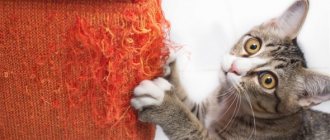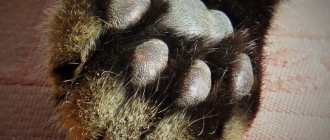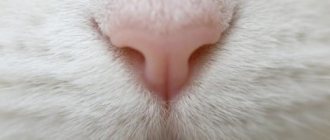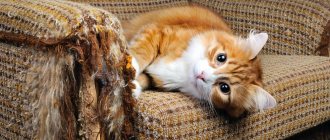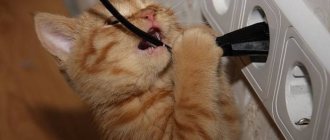You can't argue with nature
Why cats scratch furniture is well known to everyone. This is actually the only acceptable way for her to keep her claws sharp and healthy. Thanks to this hygienic procedure, old scales are peeled off from the claws and the pet receives an updated “manicure”.
We must also not forget about natural instincts, which even centuries cannot destroy. Cats simply need the act of scratching. This is their training in releasing their claws and developing their tenacity, which is very important in conditions of survival in nature. And although nothing threatens the pet, nevertheless, the skills inherent at the genetic level make themselves felt.
Cats can also relieve stress and vent anger through scratching. Can you really blame them for this? Sometimes people wouldn’t mind resorting to this method of “letting off steam.” Therefore, you need to treat the animal with understanding and find the best methods to protect furniture from damage.
Special spray
Using a spray, you can create boundaries, thus protecting pieces of furniture. This will confuse your pet and he will think that his territory has already been marked. A similar remedy is easy to prepare yourself. The raw materials for it will be mint, garlic, citrus juice, and essential oils.
Holiday casserole: I wrap leeks in ham and place them on top of potatoes.
Waffle cake recipe: a simple dessert that is not embarrassing to serve to guests
Malinin's daughter took after her father. What is Ustinya doing now (new photos)
Ways to save upholstered furniture from cat claws
If a cat is tearing up the sofa, then do not despair; there are many methods that will help solve this problem. So you won’t have to part with your pet or suffer from the unflattering appearance of upholstered furniture.
scratching post
One of the most common ways to protect sofas and armchairs from the ruthless paws of cats is a scratching post. It can look different, for example, in the form of a plank upholstered with thick fabric or coarse rope. It is mounted on the wall in a place convenient for both the animal and the owners. A scratching post can also be an integral part of a cat's entertainment complex or an independent column on a stand.
The cat may not begin sharpening its claws in a specially designated area right away. He needs to be accustomed to this. It is necessary to conduct a couple of “lessons” by moving the cat’s paw along the scratching post. Over time, the pet will understand and remember what the owner requires of him. Kittens are especially easy and quick to train, so you should not put off scratching lessons, but rather accustom the animal from childhood to the established order in the house.
Replacement covers
Replaceable covers will help protect your sofa upholstery from scratches. They have a number of advantages, but also one significant drawback. So, first things first.
The advantages of replacement covers are:
- direct protection of the sofa upholstery from damage;
- hiding traces of a “cat crime”, that is, existing damaged corners;
- weaning the animal from scratching the sofa, since cats sharpen their nails only on something stable, which cannot be said about fidgeting covers;
- adding variety to the interior due to the new appearance of the sofa.
The disadvantage of replacement covers is the financial part. Of course, replacing them is cheaper than buying a new sofa, but frequent changes of covers also require certain unplanned costs.
Claw attachments
There are special silicone attachments for cat claws on sale. They are held in place by special glue and save the upholstery. But such caps need to be changed at intervals of several weeks, and the cat needs to have a manicure. It turns out to be both troublesome and expensive, especially if the procedure for replacing the covers is carried out in a pet salon.
Special sprays
There are special sprays for furniture with an animal-repulsive odor, the presence of which discourages any desire from the cat to sharpen its claws. But such sprayers raise doubts. Often the animal gets used to the smell and continues its “criminal” business.
Noise effect
Some try to use the animal's fear to wean it from scratching upholstered furniture. In such cases, inflated balloons are used, which burst and cause the cat to flee. Aluminum pots or bowls are laid out on the floor (the main thing is that its covering allows it) next to the favorite scratching places, and when they touch them, the pet is frightened by the resulting sound and capitulates. But this method can also get pretty boring for the owners. It is also not acceptable in a family with small children.
Double-sided adhesive tapes
Cats do not like slippery and sticky surfaces, so they are unlikely to enjoy scratching their claws on adhesive tape that can be attached to problem areas on the sofa. Over time, the cat should get used to this idea and leave the upholstery alone.
Punishment with a treat
Some try to resort to training methods. For an offense, the cat is deprived of a treat and this is repeated until the animal understands what’s what.
Declawing
The most radical and at the same time cruel method to save furniture from cat claws is to completely destroy these very claws. This procedure is called onychectomy. Her whole nightmare consists of completely removing the animal's claws, including part of the paw pads. In fact, the cat becomes disabled from both a physical and psychological point of view.
There are also a lot of different folk methods on how to stop a cat from tearing up furniture - using citrus peels, spices, foil and other things. You can try all the methods, in the end you will definitely find one that will solve the problem once and for all.
Source
What kind of coverings is a cat indifferent to?
The cat chooses hard surfaces of furniture items for sharpening its claws for a reason. In the natural environment, they often scratch the bark of trees, but at home they find a completely alternative solution in the form of interior furniture.
In addition to wooden facades, they are attracted by the soft upholstery of sofas and armchairs. Thick curtains, walls with wallpaper and carpets are also quite suitable for sharpening claws.
If you have started renovations in a house where a cat lives, you can pre-select materials for interior decoration that are unsuitable for sharpening claws.
Which surfaces are not interesting for furry friends:
- fiberglass wallpaper;
- ceramic wall tiles;
- fake diamond;
- decorative plaster;
- plastic panels;
- high strength laminate;
- smooth linoleum;
- PVC floor tiles.
Unfortunately, manufacturers have not yet come up with furniture that would not provoke the desire to scratch their claws. To protect the upholstery of your favorite sofa and armchairs, experts recommend purchasing thick covers in advance to cover soft surfaces.
How to stop a cat from tearing up furniture
From the moment you decided to get a cat, you had to go a long way - this is accustoming your pet to the litter box, fighting for the rights of the owner of the house, grinding in characters... It would seem that it’s time to enjoy life, sitting in the evenings with a soft rumbling ball on your lap, but no – a new problem has appeared! Don’t despair – a cat can be weaned from tearing up furniture, even if it takes a lot of effort and patience. Many owners consider this behavior destructive, punishing it in every possible way, but for the pets themselves it is completely natural, associated with mental and physiological needs. Today we will figure out together how to stop a cat from tearing up furniture, look at the best methods and give a lot of useful tips.
How to stop a cat from tearing up furniture
Tried everything, but it doesn't help
We have listed the most common and effective ways to wean your domestic cat from scratching furniture and walls in the house. If your pet turns out to be more cunning and smart, and all the expert advice did not help solve the obvious problem of property damage, let’s try other methods of dealing with the cat’s bad habit:
- We use silicone claw attachments. They are fixed with a special glue, which prevents the protective element from accidentally falling out during the life of the pet. The cat does not experience any particular discomfort when wearing silicone attachments, except that it loses the ability to jump to heights and cling to various surfaces with its claws to overcome peaks. As new claws grow, the caps come off. In the future, you can repeat the protective procedure using silicone tips.
- We cover the attractive surface of upholstered furniture with durable covers made from fabrics that are not suitable for sharpening claws.
- If a cat sharpens its claws on walls with wallpaper, you can replace the damaged material with another that does not arouse the animal’s interest. For example, cover the corners and parts of the wall accessible to the furry beast with plastic panels or lay ceramic tiles at a certain height.
- Use special repellent sprays for cats. They have a characteristic odor that is unpleasant to animals. They can be used to spray furniture and wall surfaces. The effectiveness of these products has not been proven. As practice shows, ready-made formulations do not work in all cases. But, if other methods have not helped to wean your cat from scratching furniture, we still recommend trying this option.
- If your cat only scratches the sofa in one room, try not to leave her alone with her favorite scratching post. When leaving the room, close the door tightly behind you.
Cats are very smart animals, so before you look for a way to wean yourself from a bad habit, learn to understand its mood and feelings. Be sure to find out the reason for this behavior and try to eliminate it.
If your pet is stressed due to certain events in her life, try to surround her with care and love. Such feelings will help overcome fear and nervousness, which will eliminate the need to scratch your claws on sofas and other furnishings in the house.
There must be certain restrictions in raising a pet. Don't let your cat make her own rules and live the way she wants. Immediately designate its place in the house and in case of any attempts to “mark” the sofa in the room, give a strict command “No!”
Never use physical force in raising your furry pet! A defenseless animal can suffer greatly from even a minor blow from you. It should also be taken into account that many purebred cats have a good memory, and any physical action on the part of the owner is postponed for many years.
At the first opportunity, your cat will definitely take revenge on you, for example, it may relieve itself in your bed or scratch you severely while playing together.
We hope our article will help you find a suitable way to stop your cat from scratching the sofa and other pieces of furniture in the house.
On our website you can also find answers to questions - how to stop a cat from pooping on the sofa and useful tips for the proper upbringing of pets from experienced veterinarians and breeders.
More articles on this topic:
Cats are incredibly smart, sweet, inquisitive and active animals that give us a lot of joy and positivity. But some behavioral habits, seemingly innocent pranks of a small kitten or an adult cat, cause owners a lot of problems. For example, cats, especially growing cats, love to hang or ride on curtains. This harmful habit is characteristic of both high-pedigree and ordinary mongrel cats. If you know this problem firsthand and you don’t know how to stop a cat from climbing curtains, we recommend reading this article.
How to stop a cat from tearing up furniture
There are many ways that can help you stop your pet from scratching furniture. Let's start with the most popular ones.
Loud sounds, voice command
Every time the cat tries to sharpen its claws on interior items, loudly and sharply say “No!”, “No!”, “Shhh!” Continue this until the pet retreats from its goals.
Note! You shouldn't swear at a cat when it has already sharpened its claws. Do this before or in the first seconds of turning, so that this activity is associated with punishment. The cat must understand why exactly you are scolding him.
Another effective way to wean yourself from a “bad” habit is regular baby rattles . You can buy a rattle or make it yourself - for example, put a few coins in a metal jar (found in the kitchen), seal it and always keep it near you. Noticing that the cat wants to do some mischief again, take the can and rattle it loudly. The animal will quickly run into the next room, because it does not like such strong sounds. Rattle every time to reinforce the learned material!
Balloons are another good “sound” parenting method, although not the most convenient for the owner. Inflate and tie several balloons and secure them at the crime scene. The trap must be designed so that one of the balls bursts during the next claw point. The loud sound will scare away the animal and the next time it will be afraid to approach the ill-fated chair.
The cat is tearing up the furniture
Spray bottle with water
Cats, as you know, do not like water procedures, so why not take advantage of this? Fill a container with a spray bottle with water and spray your pet every time he intends to sharpen his claws in a prohibited place. But do not forget that such a “shower” is effective only before the incident or within five minutes after it, otherwise the animal simply will not understand why it is being punished. Unpleasant sensations, as in the previous case, should be associated with a “crime”.
We arm ourselves with... smells!
Representatives of the cat family cannot tolerate the aroma of onions, vinegar and citrus fruits. It is better to give preference to the third option, since the vinegar disappears quite quickly, and the smell of onions will be unpleasant for you. Mix lemon (orange, tangerine) aromatic oil with the same amount of eucalyptus in a container with a spray bottle. Spray furniture, wallpaper or other necessary items with the resulting solution. The advantage of this method is that it will not only wean the cat from tearing up furniture, but will also fill the home with pleasant odors.
Lemon oil
In addition to citrus fruits, you can use various spices. Pour coriander, ground chili pepper or other strong-smelling seasonings into the bag, then hang it (the bag) in the desired place.
Sticky surface
The feeling of stickiness is just as unpleasant for cats as water procedures, and therefore you can stick double-sided tape on the most attractive places (for example, armrests, the back of furniture).
You can also use special adhesive tape Sticky Paws (translated as “sticky paws”), which can be glued almost anywhere - on the carpet, upholstery, curtains. Such tapes are practically invisible, and therefore will not spoil the interior of the room.
Sticky Paws Cat Tape
Nail trimming
When trimming the sharp part of the claw, you must act with extreme caution, otherwise you may harm your pet. It is advisable to entrust this matter to a qualified veterinarian. Although it is quite possible to learn how to trim your claws yourself. You just need to do this to a certain length and at the required angle, using exclusively special scissors.
Scissors for trimming cat claws
Important! It is strictly not recommended to use scissors for dogs! The shape of the claws of these animals is different! And after trimming, be sure to reward the cat so that the process is not just torture for him.
Closed doors
If there are any expensive items in the room, keep the doors closed as soon as the cat arrives. Choose a type of doorknob that will not open if the animal pushes with its paws.
Door lock
Or you can make such a device at the bottom of the door leaf.
Screw at the bottom of the door
Video - How to stop a cat from tearing up the sofa and wallpaper
scratching post
An excellent solution to the problem. Typically, you can make a scratching post with your own hands, but to do this you need to take into account several important nuances.
- The place should be as comfortable as possible for the pet.
- The height should correspond to his height.
- The scratching post must be secured securely so that it can withstand the load.
- The top layer should be made of a rough material of medium hardness, reminiscent of tree bark. An excellent option is sisal rope, although you can use other materials.
Scratching post on the wall
The cat always considers himself the master of the house, and therefore is unlikely to limit himself to just one place to demonstrate his power. If you have a large apartment or you are the happy owner of several cats at once, it is better to place 2-3 scratching posts where the animals most like to be.
Kittens and scratching post Scratching posts for cats
Why do cats scratch furniture and wallpaper?
scratching post
Stopping a cat from sharpening its claws on furniture and tearing wallpaper to ribbons is a real challenge. A pet treats a person as a representative of its species, trying to prove its high family status. Cats sharpen their claws not because, like fashionistas, they are dull and require cosmetic intervention.
Reasons include:
- If poorly cared for, the cat will scratch the wallpaper to clean its claws. It’s a fungus, or debris has accumulated between the fingers; the instinct of a predator, sitting in ambush for a long time, requires cleanliness.
- The cat is tearing up the sofa to mark its territory, just like urine. Moreover, the higher the “traces of crime”, the higher the rank of the cat. Torn wallpaper on the wall serves as a visual indicator: “This is my territory!”
- Another reason is resentment. Cats are emotional animals. They get offended if there is no proper attention and affection. Imposingly approach the chair and demonstratively tear the upholstery with your claws... There was no need to ignore it when he was caressing. Attention and catch-up are guaranteed.
- Furniture brings into the room a barely perceptible smell of building and finishing materials. But not for cats. If an animal intends to turn the closet into sawdust, perhaps it’s a matter of “ambergris.” The furniture is expensive, but your pet also runs the risk of getting sick.
But tearing up wallpaper for the sake of exercise is the fantasy of the authors of texts on “cat” sites. Cats are not interested in waist size. Better sleep for another hour.
Hi all! Sometimes it seems that cats and upholstered furniture are literally made for each other. This is exactly what these fluffy little balls think, for some reason considering our furniture as their tool for sharpening their claws.
That’s why many people think about how to stop a cat from tearing up the sofa. The problem is truly relevant and pressing. I'll try to give some advice. Plus we will understand the very nature of cats. Still, not everyone knows why they do this and what goals they pursue.
If the cat starts scratching the doors, not only the upholstered furniture suffers, but also the wallpaper and corners, then you definitely need to look for a solution. You can’t continue to let the furry one behave like this. But punishing him is also not an option.
Even if he is madly in love with a cat, the owner will not be happy to see scratched furniture and walls. We have to look for a solution on how to stop a cat from tearing up wallpaper, sofa, carpet and other interior items. Let's look at simple training methods that will discourage the animal from sharpening its claws in the apartment. After all, the thought of punishing a pet is a nervous stress for a zealous owner.
After radical methods have been discarded, you can begin to search for a suitable way out of the situation. The best place to start is by providing your home pest with a quality replacement in the form of a scratching post. Moreover, this should be done at the first sign that the pet has taken a fancy to a leather sofa or soft chair, before he strips the item down to its filling.
The cat himself will not sharpen his claws on a new, incomprehensible product; a lot will have to be done for him to understand that the replacement is equivalent:
- First, the product can be leaned against the piece of furniture that the animal is purposefully damaging.
- Additionally, it is worth taking the cat by the paw and gently moving it along the surface with a high level of tension and resistance. Cats like to scratch precisely these areas, so sometimes even one practical lesson is enough.
- Affection is pleasant even for a cat, so every time you need to praise an animal that independently chose a scratching post rather than furniture.
In addition to providing something to sharpen its claws on, you need to make sure that your cat loses interest in anything he previously scratched. Otherwise, you may encounter a situation in which the animal eats everything indiscriminately.
- You can use citrus essential oils to stop it from scratching your favorite leather sofa. Just a few drops, rubbed over the surface of the upholstery or diluted in a large amount of water and sprayed over its surface, will drive away a stubborn animal. You just need to remember to update the smell.
READ Feeding dogs: puppies and adults: natural and dry food.
Dog feeding standards and diet Tip: At the same time, it is worth stimulating the cat’s interest in the scratching post. To do this, add a few drops of valerian or catnip onto the product.
- Cats hate it when their claws and paws stick to the surface they are scratching. A few strips of double-sided tape will quickly cool the animal's interest in the furniture. True, this is recommended to be done only in the case of a leather item; the fabric noticeably deteriorates from the prolonged presence of glue on it.
- Silicone attachments are gaining particular popularity in the fight against cats who like to sharpen their claws. They are attached to natural elements using animal-safe glue. The only inconvenience is that the nozzles will have to be changed regularly. And this technique will not help if the animal not only scratches, but also gnaws the surface.
In extreme cases, you can get by with covers. They are best made from soft fabric and folded. For a cat to scratch the surface, it must be dense. If an animal tears at the fabric, but it gathers in waves and does not stretch, it will quickly lose interest in the area.
If time has been lost and the cat has thoroughly torn up the furniture upholstered in fabric, restoring a specific area using the same material or an original decorative insert can help. A leather sofa cannot be restored so easily; you can only mask shallow scratches on your own. In case of serious damage, it is better not to try to do anything at home, but to immediately contact a professional.
- Olive oil. The use of this component can save, even if the animal prefers to sharpen its claws on light skin. It is first recommended to test the method on an inconspicuous area of the material and only then begin restoration. Take slightly warm olive oil and a thick cotton pad. We soak the cotton wool in the oil, squeeze it out thoroughly, and gently wipe the scratch itself and small areas of skin around it. We work in a circular motion in one direction. After this, we wait until the composition dries and evaluate the work. In some cases, a scratch may disappear without leaving a trace after just one treatment. If necessary, repeat the manipulation.
- If a cat slightly scratches a dark leather sofa, it is better to use shoe polish. We select the product of the required shade, apply it to a cotton swab and carefully rub it into the damaged surface. We wait until the mixture dries and wipe the area with a clean paper napkin. We evaluate the work and, if necessary, make several more approaches.
- If the furniture is covered with deep scratches, you will have to do the following. We use the oil approach first (regardless of the color of the material). Then we treat the area with oil again, put a cotton cloth on it and wait for the liquid to be absorbed into it. After this, we take a new piece of fabric, moisten it with water and apply it to the damaged area. Iron the flap with a warm iron, holding it for no more than 8-10 seconds. If necessary, repeat several times. From this effect, the oil will be absorbed better, masking the scratches.
The sooner you start implementing the above methods, the greater the chances of saving the furniture without sacrificing the health and good mood of your pet.
It is not easy to stop a cat from tearing furniture and wallpaper if it has already become a habit. Some owners prefer to change the type of wall and floor coverings. For example, cats are indifferent to plastic panels, ceramic and PVC tiles, high-class laminate, artificial stone and decorative plaster. Some people prefer to cover upholstered furniture with thick fabric upholstery.
However, we must understand that even replacing the coating or an alternative to it will not be able to permanently wean the cat from scratching its claws and gnawing objects. This process is natural and vital. Therefore, you will have to not only wean yourself off, but also think about how to switch your attention to other subjects. Let's consider the most effective methods of protection.
Repellent odors
You can try to wean your pet from a bad habit by treating his favorite scratching areas with a product with an unpleasant aroma. It is known that cats do not like the citrus smell, so this is worth taking advantage of. This can be orange, lemon peel or essential oil. However, oil is inconvenient because it leaves unsightly greasy stains on the surface.
Protective coatings
You can save the upholstery of a sofa and armchairs by using covers made of special fabric or so-called anti-vandal Euro covers. In specialized stores you can choose options with a coating that is too tough for cats and not for their claws.
They simply will not be able to stick their claws into the fabric.
You can stop your cat from scratching the upholstery and damaging the surface of the wallpaper in a more effective way by cutting the claws or gluing special plastic covers on them. To trim claws, purchase a special device - a nail clipper, literally cutting off 1-1.5 mm of the regrown length. The device is quite convenient and allows you not to stretch out the procedure, and therefore the cat does not have time to get nervous.
The pads are put directly on the claws, having previously lubricated them inside with special glue. Don't worry too much about it being harmful. As practice shows, the glue is not so strong, but for some time the cat will not be able to damage the furniture upholstery and wallpaper.
Alas, at the same time she will not be able to retract her claws, and it will be difficult for her to jump, but she will still be able to provide temporary protection to objects.
To prevent your cat from sharpening its claws and teeth on furniture, wallpaper and curtains, you can try using a spray bottle. Scaring can have an effect on individual individuals if it is done at the moment when the animal is tearing upholstery fabric or wallpaper. You can also spray your favorite items with a special spray to repel your pet. Citrus-scented sprays are repulsive to some cats.
Available means
You can protect furniture and wallpaper using another method. For example, favorite places can be covered with sticky, sliding or rustling material on top. For example, stick double-sided tape or foil to the torn area of the wall.
Making a scratching post with your own hands. Master Class
Let's look at one simple and inexpensive way to make a cat simulator. To do this, prepare in advance:
- a round wooden plate (ø35 cm), cut it out before starting work;
- tape (yellow, pink or white);
- wooden beam (40x40 mm) 0.7 m long;
- scissors;
- electric drill, screwdriver, and wood screws of sufficient length;
- glue, construction stapler;
- white cover (40x40 mm), these are used for switches;
- white paint;
- nylon rope (50 m);
- fabric dye (yellow or pink).
A beautiful scratching post made from scrap materials
Step 1. After preparing everything you need, you can start making your own scratching post. First, secure the beam in the center of the base. It is important to accurately determine the center of the circle, otherwise the appearance of the entire product may be spoiled. After fixing, paint the circle with white paint.
The post is attached to the center of the base
Step 2: Start painting the rope. By the way, this rope is lighter in color and therefore better than sisal or jute. Although nylon itself is less durable, this is not so important - scratching posts do not last very long, their service life (both homemade and purchased) is limited.
Painting nylon rope
Step 3: When dyeing, follow the instructions that came with the fabric dye. Then the rope should dry thoroughly, for which it can be laid, for example, on a radiator. This may even take the whole night, so it is better to postpone further work until the next morning. Moreover, during this time the smell of the paint with which you painted the round base will have time to disappear.
The rope must dry well
Step 4. You can start winding. To begin, nail one end of the rope to the block, as shown in the photo below. Also be sure to spread the glue all over the post. If you use ropes of different colors, connect them using colored tape (pink on the pink area, etc.). Seal the joint between pink and yellow with pink tape, which will look like a continuation of the pink edging. This is why you don’t need to buy tape in all three colors.
The post is wrapped with rope
Step 5. Secure the second end of the rope on top with the same stapler, and cover the remaining area with a plastic cover. In the absence of the latter, simply paint the area or decorate it as you wish.
The remaining area is covered with a lid
Step 6. The scratching post is ready for use! If you don’t have the time/energy/desire to make this option, you can try making another one (step-by-step instructions are given below).
Photo of the finished scratching post
Table. Making a scratching post from corrugated cardboard.
| Steps, photo | Description of actions |
| Step 0 | To begin, prepare everything you need - thick corrugated cardboard, a screwdriver, a template with diagrams of all levels of the future design, an electric drill, a wooden dowel, a knife for cutting cardboard, screws, plywood, as well as a convenient surface on which you will cut the levels. |
| Step 1 | Mark the center of the plywood base. Take a drill and, placing plywood between a pair of chairs, drill a hole at the mark. |
| Step 2 | Next, using the same drill, drill a hole in the center of the dowel, as shown in the image. This hole will make the next step much easier for you. |
| Step 3 | Take a screw, screw it into the board, and then screw the wooden dowel to the plywood base. Holding the screw with a screwdriver, take the dowel with your other hand and screw it (the screw) to it. It is important to hold the dowel until it is screwed tightly. Manually screwing in the dowel allows you to control the process and, as a result, fix the element straight. |
| Step 4 | Start cutting out the templates. Prepare in advance and then print out templates for all seven levels of the future product. Templates should be drawn on cardboard and cut out. |
| Step 5 | Take the templates and use them to draw shapes on the corrugated cardboard. |
| Step 6 | Cut out the layers along the contour. Using a knife, use a knife to cut out the cardboard using the drawn outline. It is important that the knife you use is sharp, otherwise you may damage the cardboard. |
| Step 7 | Start assembling all layers. Stretch the cut cardboard layers one by one onto a wooden dowel. There is no need to glue the layers together - this will allow you to replace one of them in the future if damaged. |
As a result, you will get something like this scratching post. As you can see, there is nothing complicated here; the work can be completed in just a couple of hours.
DIY scratching post for cats
Below is another interesting option - a small claw in the shape of a fish . Although you can choose any other shape. The idea is to cut corrugated cardboard into strips 10 cm wide and gradually wrap them around each other. However, all stages of production are shown below.
DIY scratching post in the shape of a fish
Buy a scratching post!
To maintain the integrity of the furniture in the house and prevent scratching the walls, purchase a special design for scratching claws - a scratching post. It is advisable to do this immediately after your pet arrives in the house in order to quickly accustom him to this product, which allows him to perform manicure procedures without damaging property.
Pet stores offer a huge selection of scratching posts of different models, for every taste and budget:
- simplified options in the form of a comfortable board upholstered in natural fabric;
- scratching posts in the form of a carpet and inclined models;
- floor and wall structures;
- model houses and various figures;
- multi-storey structures with a play area and a place to relax.
The selection is amazing! The main thing is not easy to choose a beautiful, but really comfortable and safe scratching post for your pet.
It is not difficult to accustom your cat to a new nail sharpening design. You can use pleasant smells to attract her, arrange fun games using this accessory, or lure the fluffy beauty with your favorite treat.
You can read more about this in our article on the topic “How to train a cat to use a scratching post.”
How to train a cat to use a scratching post?
The “unit” for sharpening claws is usually located where the pet is used to doing it. As mentioned above, if there are several such zones, then there should be the same number of scratching posts (ideally).
- If the animal has its own sleeping place, then the scratching post should be placed there (cats always warm up after waking up).
- You can show your cat how to use a scratching post - first of all, move his paw along the column (this should be repeated several times).
- It is better to cover or take away all distracting objects so that the pet can focus more often on the scratching post.
- Place foil, adhesive tape or slippery plastic on the floor in the place where the cat likes to tear wallpaper or furniture.
Getting the cat used to the scratching post
Note! Every time your pet uses the scratching post, reward him, pet him and give him compliments.
You should not lure your pet to the grinding “unit” with valerian. Having gone crazy, the cat will bury its nose in the scratching post, rub against it, meow loudly and perform various circus acts, without even remembering its direct purpose.
Why cats love to climb curtains
The appearance of a kitten in the house is not only a joyful event, but also a great responsibility. The owner must not only create optimal living conditions, but also pay great attention to raising the pet. The cat must know what is allowed and what is not.
At the same time, you need to understand that, unlike humans, our smaller brothers practically cannot resist their natural instincts. For example, cats are inquisitive, active, and cannot live without heights, being in a confined space where there are no trees or other various elevations. Therefore, kittens happily climb onto vertical surfaces, furniture, and other heights, from where they have an overview of the territory and, of course, cannot ignore curtains, curtains and tulle.
As a rule, cats use curtains in the following cases:
- for games;
- as a safe place when the pet is frightened by something;
- to attract attention or simply out of boredom;
- to wrap yourself in them.
Little kittens jump on curtains not only because of hyperactivity, stupidity or stubbornness, but also because of curiosity or bad manners.
Adult cats are less likely to show interest in curtains, but it is possible that if the cat is scared and experiences severe stress, he will climb the curtains and curtain rods at every opportunity.
Other methods of raising a pet
Try using other methods - it is quite possible that one of them will help bring your cat to reason.
- Aerosol . Let’s immediately make a reservation about the dubiousness of this option, since usually mustachioed people still continue to scratch furniture treated with special sprays.
Beaphar Stop It Cat Repellent Spray Protective Covers . They are stretched over furniture not only to protect against pets, but also to cover tattered fabric. According to manufacturers, elastic covers are not very suitable for cat activities due to mobility and low stability. Stretch covers are quite easy to clean and wash, and their cost is noticeably lower than a new chair. Sofa with cover “Soft claws” . If you don’t want to bother with covers, rattles, tape, etc., you can pay attention to the animal’s claws. For example, you can put special silicone attachments on the claws of the front paws, which follow the shape of the claw and are attached with glue, but do not hinder reflex movements. That is, the claws will calmly retract and extend. Typically, such caps come off along with the stratum corneum after 2 months, but if desired, they can be re-glued. Anti-scratch for cats Declawing . A radical method that only heartless owners resort to. Onychectomy is a surgical operation during which the claws are amputated along with the phalanges of the fingers. As a result, the pet becomes disabled - the coordination of its movements is impaired, the cat constantly loses its balance, cannot stay on heights, its spine hurts, and its posture is disturbed. If such an animal ends up on the street, it will find itself completely defenseless there. Cat declawing is not a cosmetic procedure, not a “pedicure”, but a serious operation during which the phalanges of the fingers are amputated
What not to do
Most people do not know that their prohibitions and threats do not apply to cats. The animal will always do what it wants, without taking into account your opinion. Therefore, when weaning Vaska from a bad habit, remember some important points.
- You should not resort to any physical punishment (the pet will harbor a grudge and will definitely take revenge on you).
- Shame the cat only during the “crime” (belated lectures will not bring him sense).
- You should not throw away an old scratching post, the smell of which is familiar to the animal (it will have great difficulty mastering a new one).
- Finally, you should not yell at your cat (use intonation, but not volume of voice).
Owners of cats who exercise daily are lucky in this regard, because any tree is a large scratching post, for the use of which no one will swear.
Video – How to stop a cat from sharpening its claws on furniture
Scotch tape and other methods of protection
It has long been known that cats do not tolerate sticky surfaces. To prevent your pet from wanting to scratch the sofa again, you just need to stick double-sided tape on the restricted area.
Due to the fact that people tend to fall uncontrollably in love with their furry pets and at the same time value their possessions, protective caps for cat claws were invented. Now animals can walk around with a beautiful colored manicure in the form of caps, and the furniture can remain durable. Typically, anti-scratch pads are made of silicone or soft plastic, and are attached with medical glue.
Also on sale are socks for animals or paw pads, which can also be used to save household items. Which of these is better to choose, in particular, depends on the nature of the pet. There are such calm animals that are absolutely fine with the fact that they will walk around the room in socks.
The final method is to install vinyl clear panels on your furniture. They come with screw pins, making installation simple and convenient. The protective film is available in different sizes.
Found a violation? Report content
How to buy a cat?
If you are interested in whether there are “well-bred” cat breeds in the world, then we have to disappoint you - alas, there are none. But there are some practical tips that will help you when buying a pet:
- buy a three- or four-month-old kitten (the character is already indicated, and the owners probably taught him to use a scratching post);
- give preference to breeds that are focused on communicating with people (for example, British Shorthair) to make it easier to achieve mutual understanding;
- In terms of neatness, a purebred cat can surpass even the most purebred “competitors . But here it is better to purchase an already adult pet, so as not to buy, so to speak, a pig in a poke.
5 / 5 ( 7 )
Source
Alternative options
If the tips described above did not help, the cat continues to show interest in curtains, replace them with horizontal, or best of all, vertical blinds. The slats should have a smooth, glossy metal surface. The cat will not be able to climb them. No subject of interest - no problem! Don't forget that cats love to sit on the window and watch what's happening outside. Therefore, move the blinds to the side or lift them.
You can move the curtains to one side or lift them up so that the fabric is out of reach of the “tenacious” paws. Over time, the pet will lose interest in them. If this does not help, remove the curtains from all window openings for a while. After the windows are covered again, carefully monitor the cat's behavior and actions. If the prankster takes up the old ways again, have an “educational” conversation in a stern tone with the pet.
Advice! If a kitten jumps on the curtains and ruins the curtains, be sure to purchase a high scratching post from the pet store (preferably one mounted on the ceiling).
The temptation to hang on the curtains or play with the curtains increases in your absence, when no one is home, and the cat can play pranks with impunity. Therefore, when leaving home, close the rooms where the window openings are decorated with curtains. You can also use special motion sensors that are fixed on the curtains and are triggered, making sharp sounds, as soon as the cat tries to hang on them.
Trim your pet's nails every three to four months. If the procedure is carried out periodically, the animal, lacking long, tenacious claws, will forget about its capabilities.
Switch your active pet's attention to other objects. Don’t leave your kitten unattended, provide it with a variety of toys (wind-up mice, balls), a house, arrange a “training” area, or purchase a play complex for cats with multi-level playgrounds. By keeping your cat varied and active, you don’t have to worry about the safety of curtains and other interior elements.
Involve your cat in active joint games. If possible, the pet is vaccinated, completely healthy, treated for ectoparasites; periodically in good weather, take your pet cat for a walk outside, but only on a leash.
There are many ways to help stop your cat from climbing or playing with curtains. Try each option, as each animal is different.
Show patience, persistence and consistency in your actions if you want to raise an obedient and well-mannered cat.
Any person who has a furry, clawed pet always asks the question: how to stop a cat from tearing up furniture? Most often, owners perceive this behavior as sabotage, the harmfulness of the animal, and rarely delve into the real reasons why the cat is tearing up furniture:
- For cats, sharpening their claws is a natural need, as it helps to maintain their claws in good condition, otherwise they quickly grow back and dig into the pads of the toes, leaving wounds. By getting rid of the old claw, the animal makes room for a new sharp one. Scratching nails is a necessary hygiene procedure. Outdoor cats have many natural breeding grounds, unlike domestic animals, which are forced to choose from what is available in the apartment.
- In this way, they mark the territory by releasing the smell of sweat from the sweat glands of their paws, thereby informing other animals that this territory belongs to them.
When your cat scratches your favorite and frequently used sofa, she wants to tell you that she trusts, likes and loves you.
- This is a kind of exercise, since in the process of sharpening the claws, the tendons and muscles of the shoulders and paws are tensed, the muscles of the neck and back are warmed up, and maintained in good shape.
- In the process of sharpening their claws, pets train the skill of releasing them, which is embedded in their genes.
- This method allows you to relieve tension or reduce the animal’s fear. An animal living next to a person experiences many different feelings: jealousy of other animals, fear that the territory will be captured by another animal, conflictual relationships with other animals, moving to a new home, illness, etc.
- The reason may also be untimely education by the owner. The kitten will never guess what can be touched in the apartment and what cannot.
- Lack of toys and attention from the owner can also lead to criminal behavior.
You can stop a cat from scratching its claws on furniture at any age. But you need to remember that the older the pet, the more stable its habits and the more time it will take to re-educate it.
Just watch an adult cat a little and you will understand the specific reasons. If you have consciously decided to get a mustachioed pet, then you must understand in detail the inevitable question - what to do to prevent the cat from tearing up the furniture?
The ideal option would be to make repairs using durable and stable finishing materials, protect furniture with durable covers made of anti-vandal fabric, cover the corners of the walls with plastic panels, paint the walls or cover them with decorative plaster.
